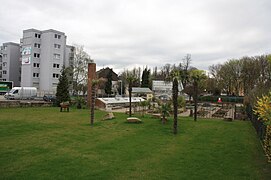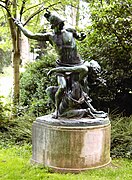City Park Düren
The city park Düren is a historically grown Volksgarten in Düren , North Rhine-Westphalia . It was renamed Willy-Brandt-Park in May 1997 . It is entered under No. 135 in the list of architectural monuments in Düren .
location
The park is located directly on the Rur and is now bordered by Aachener Strasse , Valencienner Strasse and Tivolistrasse .
Right next to the park is the former city nursery with the pavilion of the Chinese twin city Jinhua , the city's oldest tennis facility and the city park restaurant with the Ewaldus guild's listed shooting range . Across the street on Valencienner Straße is the largely listed factory site of the former Leopold Schoeller fine cloth factory.
history
In 1862 the 18 acre site was bought by the Ewaldus Guild. In 1882 the city of Düren acquired the entire area of 6 hectares, 0.3 ares and 42 m² from the guild at a price of 64,000 marks . The city park was built in 1896 according to the plans of the Cologne gardening director Adolf Kowallek . The Mayor of Düren, August Klotz, opened it on June 21, 1896. From 1898, the park strip east of the Rur was also part of the city park. The park was laid out in the style of the English landscape garden with geometric shapes. Even then there was a lawn tennis court and a children's playground .
At the turn of the 20th century, a river bathing establishment was set up on the eastern side of the Rur , which existed until after the Second World War . Opposite, on the western bank, there was a rowing boat rental. The Rur was dammed by a weir in front of the three-belt bridge .
A botanical garden and a city school garden were created in the grounds of the city gardening facility, in which, according to the administrative report of the city of Düren, “1000 species and varieties of plants could be grown” in 1897/98. The botanical garden comprised 4500 m² with a heated greenhouse .
As early as 1898 there were many concerts in the park. In 1910 the Ewaldus Guild celebrated its 350th anniversary in the 1400-person hall. As early as 1905, the main path between Johannesbrücke and Bismarckbrücke received electrical lighting instead of a petroleum lamp. During the First World War , the park and the buildings suffered greatly. The hall was confiscated by the occupying forces until 1922. The renovation was carried out on a smaller scale.
During the Second World War, a large part of the rose beds was used for planting vegetables. The destruction of the park in this war was enormous, because the Rur was the main battle line until February 23, 1945. Concerts in the city park began again in the 1950s.
Others
In the park stands the listed sculpture Defending a Sabine Woman by the Berlin sculptor Joseph Uphues .
There are two sequoias and an ancient cedar tree in the park .
The Rurufer cycle path leads through the city park on the way from the source of the Rur near Botrange in Belgium to its mouth in Roermond in the Netherlands .
The Children's Culture Festival and the Dialect Festival take place in the park every summer.
swell
- Christel Kreutzer: The city park - a favorite place in Düren through the ages In: Yearbook of the district of Düren 2014. Hahne u. Schloemer, Düren 2013, ISBN 978-3-942513-23-4 , pp. 17-30.
Coordinates: 50 ° 47 ′ 48.9 ″ N , 6 ° 28 ′ 16.2 ″ E



